In today’s modern pig farming industry, technological integration is essential for improving productivity, managing herd health, and making informed breeding decisions. One of the most transformative tools in this regard is veterinary ultrasonography. Across farms in the U.S., Europe, and Asia, ultrasound equipment has shifted from being a high-tech luxury to a practical necessity—especially for breeding and health evaluation. This article explores the specific functions of swine ultrasound devices available in the market, highlighting how they benefit modern pig farms and how global producers are applying this technology to optimize herd management.
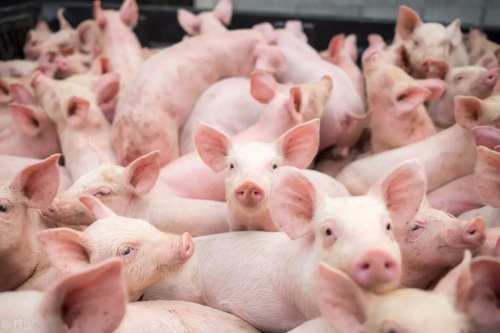
Understanding the Role of Ultrasound in Pig Farming
Swine ultrasound devices work by emitting high-frequency sound waves that penetrate tissue and reflect back to create real-time images of internal structures. Portable and rugged ultrasound machines are now commonplace on farms, especially for tasks such as pregnancy detection, fat measurement, and identifying reproductive or uterine issues. These systems are non-invasive, accurate, and repeatable, allowing farmers to make quicker, better decisions without causing stress to the animals.
Countries with advanced pig production systems, like Denmark, the Netherlands, the U.S., and China, have adopted ultrasound technology extensively—driven by the need for efficient herd management and economic viability.
1. Backfat Thickness and Eye Muscle Area (EMA) Measurement
One of the most important uses of swine ultrasound is measuring backfat thickness and eye muscle area (EMA), both of which are key indicators of carcass quality.
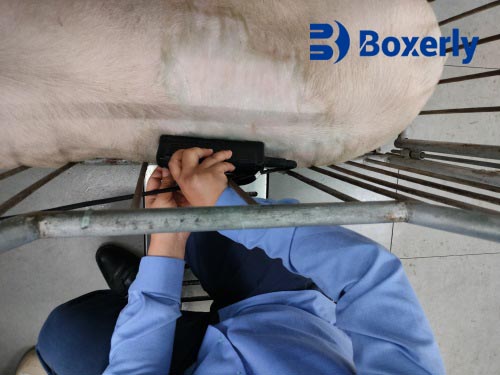
Backfat Thickness: This refers to the depth of fat between the skin and the muscle layers, typically measured at specific points along the pig’s back. Accurate backfat measurement allows producers to track body condition, estimate lean meat yield, and determine optimal slaughter timing. In Europe, for instance, regulations and carcass grading systems often require precise fat measurement, making ultrasound an indispensable tool.
Eye Muscle Area (Longissimus dorsi muscle): EMA is a reliable indicator of the pig’s muscular development. Ultrasound provides a non-invasive way to quantify muscle mass, enabling farmers to select pigs with better meat-producing potential for breeding or market. In North America, breeders often use this data to improve genetic selection.
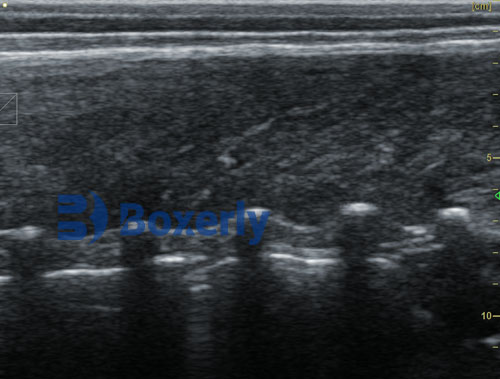
These measurements are usually taken with B-mode ultrasound machines equipped with linear probes. Devices like the BXL-V50 are specifically designed to provide stable, high-resolution images under field conditions, allowing accurate interpretation by veterinarians or trained technicians.
2. Pregnancy Detection in Sows
Early and accurate pregnancy diagnosis is one of the most widespread uses of ultrasound in pig farming worldwide.
Early Detection: Most modern swine ultrasound devices can detect pregnancy as early as 18–24 days post-breeding. This is particularly useful for improving reproductive efficiency—non-pregnant sows can be re-bred sooner, and pregnant sows can be moved to appropriate housing or feeding groups.
Fetal Viability Assessment: In addition to confirming pregnancy, veterinarians can use ultrasound to assess fetal heartbeats and fluid levels to evaluate embryo viability, especially useful in high-value breeding programs.
Application in Commercial Farms: In countries like the U.S., Canada, and Australia, large-scale operations often rely on mobile or handheld ultrasound systems to scan hundreds of sows quickly. Devices with real-time imaging and one-button measurement functions are particularly valued.
Ultrasound also eliminates the need for hormonal testing or rectal palpation—methods that are either more invasive or less accurate during early gestation.
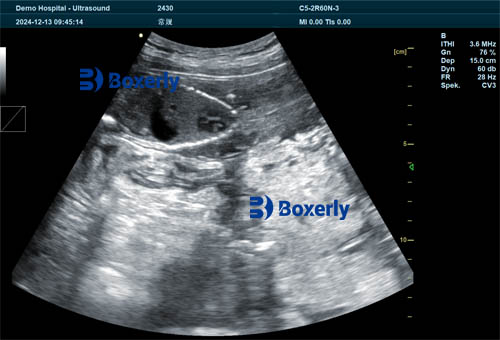
3. Estimating Litter Size (Fetal Counting)
Another important application is fetal counting. While this function is more challenging than simple pregnancy confirmation, skilled operators using high-quality ultrasound machines can estimate litter size, especially between 25 to 35 days of gestation.
Benefits: Knowing how many piglets a sow is carrying allows producers to adjust nutrition and farrowing schedules accordingly. Overfed or underfed sows are prone to complications during birth or reduced milk production.
Technological Progress: Recent improvements in image quality and software algorithms have improved the accuracy of fetal counting. Some European research farms even combine ultrasound data with artificial intelligence to refine litter size predictions.
While absolute accuracy in counting may vary depending on gestational stage and operator skill, ultrasound remains the most reliable on-farm method currently available.
4. Disease Detection and Reproductive Health Monitoring
Ultrasound is also instrumental in detecting reproductive tract abnormalities, uterine infections, cystic ovaries, or retained placentas. In both commercial and breeding herds, these conditions significantly affect productivity if left undiagnosed.
Postpartum Monitoring: After farrowing, ultrasound can be used to check whether the uterus has involuted properly and whether there is retained fetal material or excess fluid—conditions that increase the risk of metritis or endometritis.
Ovarian Evaluation: In breeding programs, particularly in artificial insemination (AI) centers in places like Canada or Germany, ultrasound is used to assess follicular development and corpus luteum formation, which guides hormonal treatments or insemination timing.
Chronic Reproductive Disorders: Ultrasound allows the detection of chronic uterine conditions in repeat-breeder sows. By identifying these animals early, producers can remove unproductive individuals from the breeding pool, saving feed and labor costs.
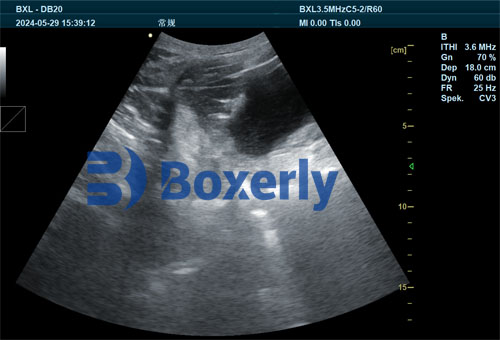
5. Portable Design and Real-Time Feedback
Modern swine ultrasound machines are typically lightweight, battery-operated, and IP-rated for dust and water resistance—features tailored to farm environments.
Real-Time Imaging: B-mode devices show real-time tissue movement and structure, which helps in guiding probe placement and immediate decision-making.
Data Storage and Transfer: Some devices allow for image capture, annotation, and transfer via USB or wireless connection. This is particularly useful in farms that keep digital health records or share results with consulting veterinarians.
Training and Ease of Use: Devices are now built to be user-friendly even for non-veterinarians, with preset modes for different species, organs, and tasks. Video tutorials, touch-screen interfaces, and one-button operation are standard in high-end models.
6. Global Applications and Trends
Across different continents, ultrasound use reflects local priorities:
In Europe, strict animal welfare laws and meat grading systems have driven high adoption of ultrasound for fat and muscle assessment.
In the U.S. and Canada, pregnancy checking and disease detection are the most common applications. Integration with herd management software is growing.
In Asia, particularly in China and South Korea, ultrasound is used both in large breeding facilities and in smallholder farms, often with government subsidies promoting tech adoption.
In Latin America, use is expanding rapidly as producers seek to increase export competitiveness and reduce reproductive losses.
Conclusion
Ultrasound equipment for pigs has evolved far beyond simple pregnancy detection. With the ability to assess body composition, count fetuses, detect diseases, and monitor reproductive health, these devices play a critical role in maximizing swine productivity, improving animal welfare, and reducing economic risk.
Whether in large commercial operations or family-run farms, the shift toward real-time, data-driven decision-making is becoming the norm—and ultrasound is central to that transformation.
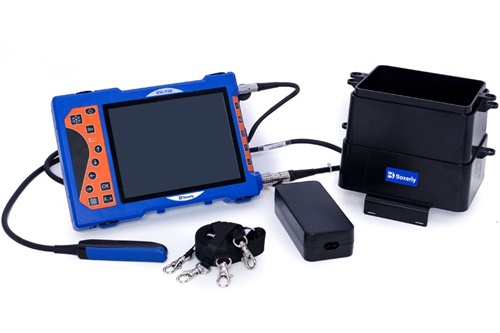
Veterinary ultrasound systems like the BXL-V50 represent this new era: portable, multifunctional, and tailored for rugged environments. For swine producers around the world, such technology is not just a diagnostic tool but a strategic investment in herd performance.
Reference Sources:
Whitaker, D. A., & Smith, E. (2021). Veterinary Ultrasonography in Food-Producing Animals. Journal of Veterinary Imaging.
National Hog Farmer. (2023). “Ultrasound technology helps producers improve pig production outcomes.”
https://www.nationalhogfarmer.com/reproduction/ultrasound-improves-repro-efficiencyEuropean Food Safety Authority. (2022). “Use of ultrasound in monitoring reproductive performance in sows.”
https://www.efsa.europa.eu/en/news/reproductive-monitoring-sowsKansas State University Swine Institute. (2023). “Practical on-farm use of ultrasound for sow management.”
https://www.ksuswine.org/ultrasound-management
tags:
Text link:https://www.bxlultrasound.com/ns/845.html


